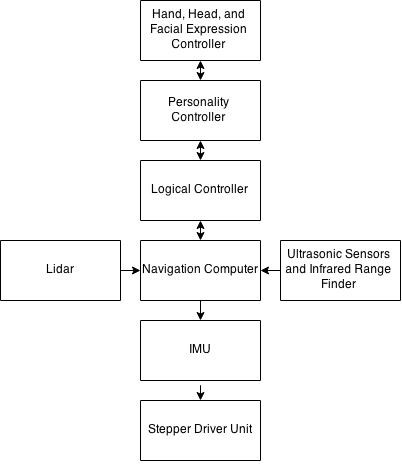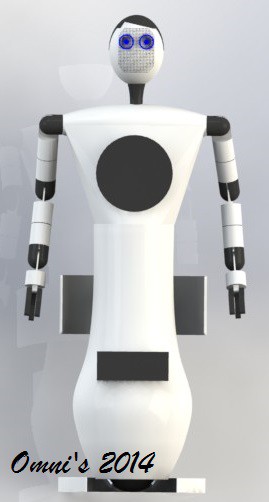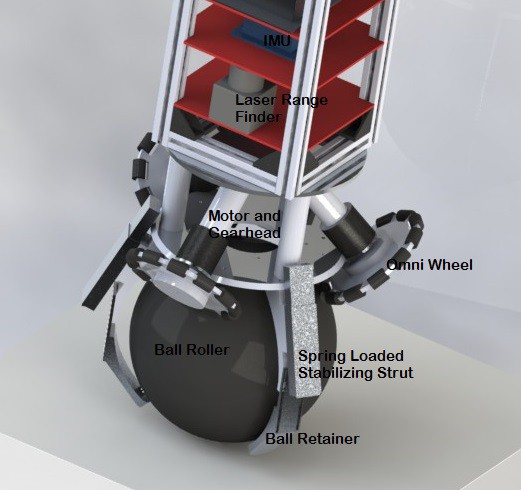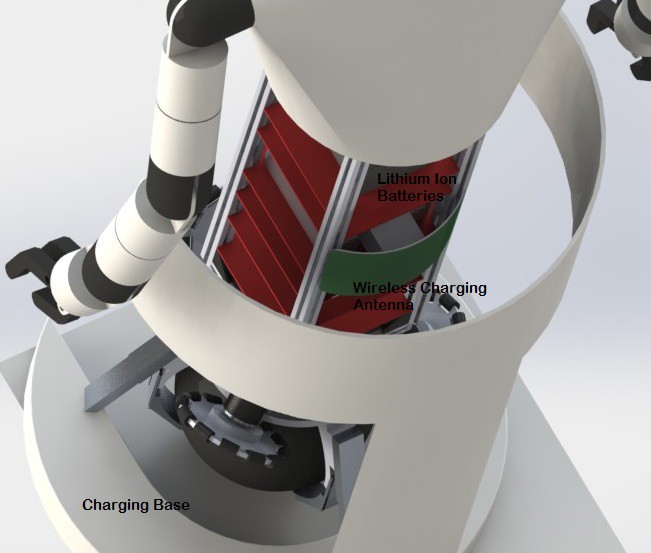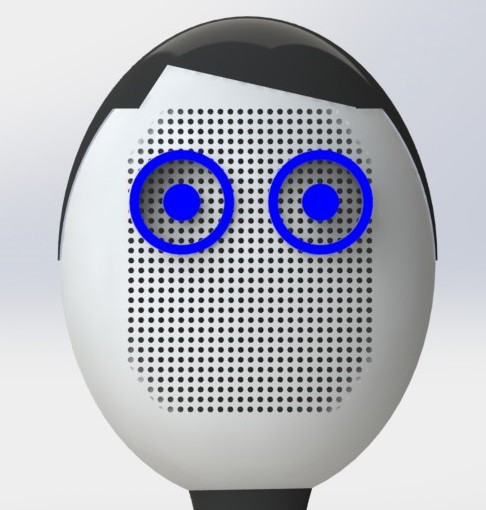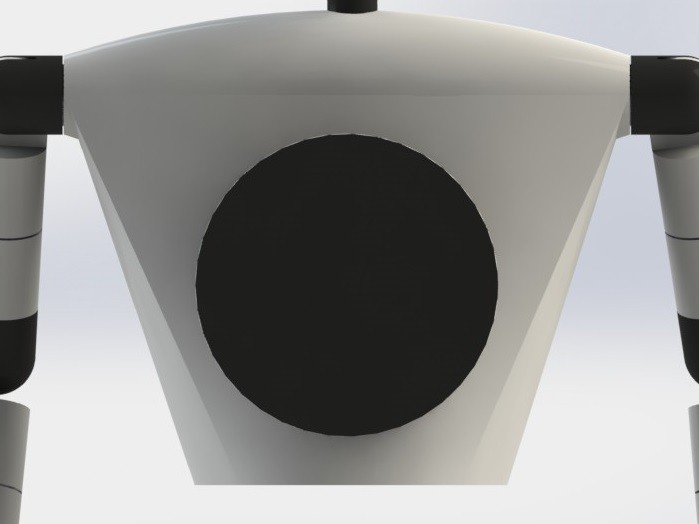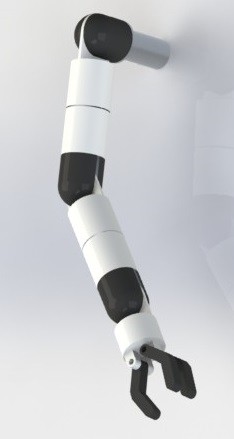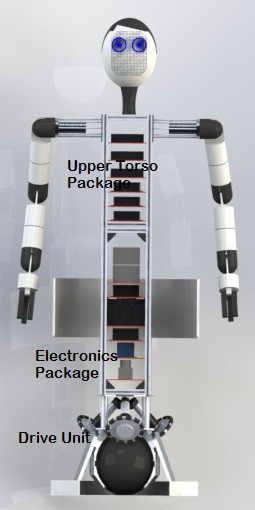For this project, we considered various technical and design considerations:
1. Form Factor
In such a service oriented industry like the restaurant industry, a close and personal touch is essential. It makes the diners feel welcomed and at ease, thus providing a conducive and pleasant dining experience. Many form factors for the robotic waiter are possible that will carry out the day to day operations of a restaurant equally well. However, to be in line with our earlier point, our team thinks that a humanoid robotic waiter, although harder to implement, will best approximate the interpersonal interaction between a human waiterand a diner. We also note that with current technology, we are not able to come up with a facsimile of a real person with complete fidelity in terms of outwards appearance and movement, thereby introducing a 'creepy' factor in the robot if we attempt to do so. Thus we have chosen to go part way on this and came up with the humanoid design (shown in figure on the right) for OSCAR. With this design we think that the customer will experience almost the same level of interaction as with a human waiter, without constantly needing to come to term with the humanistic characteristic of the robot, because the outward appearance clearly suggest it is not a human.
2. Locomotion, Navigation, and Collision Avoidance
When we think of waiters, we think of people in uniform, gracefully negotiating the narrow spaces between tables while skillfully balancing a number of items their hand as they serve the diners. Traditional statically stable (remains stable without the need for any active feedback) robots require large bases, thus a big footprint to remain stable. Due to this reason, they are not optimized for the small confines of the walking spaces in between tables or within the kitchen. Their movement are sometimes slow and not as fluid as that of human locomotion. Dynamically stable (require active feedback mechanism to remain stable) robots are more suited to this purpose. They have the advantage of having a small base thus footprint and are very maneuverable as a result of their dynamic stability.
Our team have opted for less common ball-drive configuration shown on the right for OSCAR. The concept of the ball drive is deceptively simple. It consists of three omni wheels (wheels with rollers on their circumference to allow for side way motion) driven by motors which are mounted at an angle to each other. Synchronized movement of the three wheels drive the ball roller allowing for motion in any direction (thus the omni in OSCAR) and even turning in it's own footprint. Attitude of OSCAR will be measured by the IMU. With this information together with the feedback from the rotary encoders, the computer can precisely make the necessary adjustment to maintain OSCAR's balance when stationary or moving.
We have design a set of stabilizing struts to prevent OSCAR from toppling when dormant. As a measure of safety, these struts are spring loaded and can be deployed in an instant in an event of a fault condition which will cause OSCAR to become unbalanced.
As the interior of a restaurant is relatively fixed and well defined, a map of it can be created and stored in OSCAR. Using map together with the laser range finder (the black range finder window is shown at the lower part of the torso) and head mounted stereoscopic cameras (behind the led face display), OSCAR can perform autonomous navigation and collision avoidance without the need for any markers.
3. Power Source
The power source for OSCAR is a series of high capacity lithium ion batteries mounted at the top of the electronics package (see figure below) to provide a high center of gravity. Charging will be done wirelessly with a charging base, eliminating of the need for any external contacts. OSCAR will be able to automonously navigate and dock itself for charging when the batteries are running low.
4. Interactivity
Orders taking and answering to the diners' request require a great deal of interactivity to be build into OSCAR. Firstly, the head of OSCAR (shown below) will have speakers and microphones built in allowing OSCAR to interact verbally with the diners. The led matrix face provide OSCAR with the ability to communicate through facial expression. This together with programmed arm gestures provides for a more natural interaction between diners and OSCAR. OSCAR will also spot a chest mounted touch screen which can be use to display the menu or various information for maintenance.
5. Manual Task Handling
The day to day restaurant operation for a waiter involves the task of transporting dishes from the kitchen to the diners' table, serving the dishes, and clearing the table when the diners leave. For these tasks OSCAR will be equipped with a pair of 6-DOF robotic arms with three digits for the grippers. The 6-DOF arm replicates all the possible range of motion that a human arm is capable of. The second joint in the three digits allows them to slide under the side of a plate, lifting it up and grabbing firmly onto it. The gripper will also be able to grab firmly onto table edges and chairs when repositioning them.
6. Cooperative and Assisting Behavior
The real benefit is realized when a few OSCAR units work together cooperatively. A centralized server will coordinate the workflow and charging downtime amongst the units. One interesting idea that can be implement in this framework is the idea of transferable personality. An OSCAR unit can introduce itself as say 'Phil' to a diner. It will display a certain unique face on it's head so that the diner associate that face with 'Phil'. When the same diner requests for a waiter, the nearest OSCAR unit can display the face of 'Phil' and take on that identity. Thus the diner will then have the experience of always being served by the same waiter, a faster response and the workflow in the restaurant is streamlined.
7. Scalability and Serviceability
The whole OSCAR unit (shown on the right) is designed with scalability and serviceability in mind. All the major components are modular permitting an almost infinite scope when it comes to scalability. OSCAR contains two three main modules, the drive unit, the electronics package (electronics for the ball drive, the power system and laser range finder for collision avoidance), and upper torso package (electronics to control the arms, head, chest mounted touchscreen and the logic control unit for interactivity). Control boards and computers can be swapped in and out easily from the packages. The arms and head unit can be changed for improved functionality. Even the external shell can be swapped with ease to change the appearance of OSCAR.
8. System Schematics
A possible system schematics is given here:
